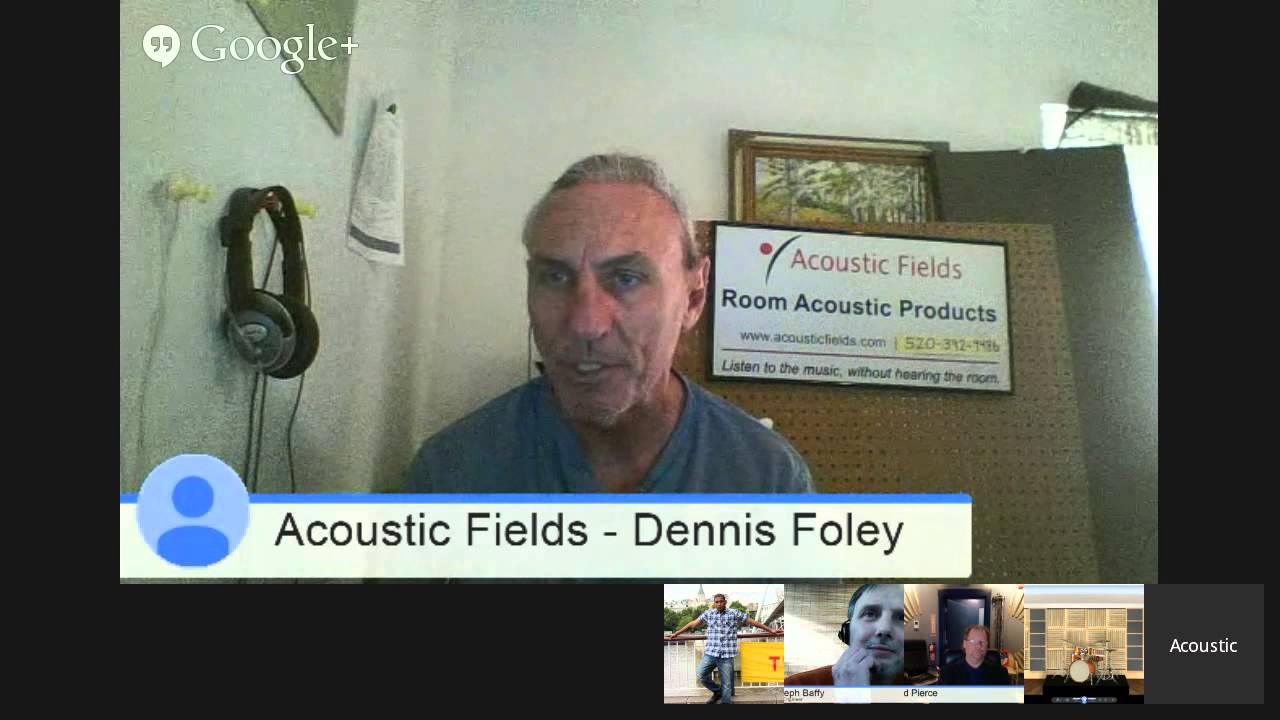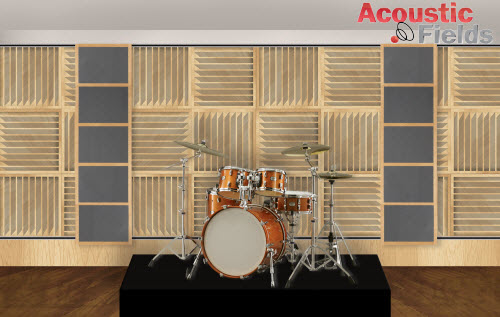In another of our monthly Google Hangouts with experienced and talented audio engineers Brad Pierce, Joseph Baffy and Joshua Wilson, we continued in our efforts to bridge the gap between what you are hearing as an engineer and how the room is causing that problem. The following video and transcript comes from one particular section where we addressed the issue “How To Use Variable Acoustics When Recording Drums”. If you would like to see the full hour and a half discussion you can see the video further down the page.
Dennis: It’s all about variable acoustic which Joseph is describing is a variable acoustic situation where he’s using different absorption, reflective diffusion technologies to address the issue. The following is a design I’ve come up with for a new project and I think it fits really good right here in this discussion because it addresses the pressure and the reflection issues.
This is a part of the room that we’re designing for an L.A studio project and we have a drum platform and this has carbon technology and this is directly related to pressure. Pressure is at its maximum closest to the source. We can’t get much closer to the source than this. We’re actually sitting on it. So this is a way to deal with pressure.
The rear wall is two-dimensional diffusion and we have foam panels that will add to or subtract from the diffusion coefficient that the microphone hears. So we have the ability to control pressure and to control reflections. The two main issues I think that we’ve all been discussing and the ceiling is a similar system with low frequency management and the diffusion. But this side wall is the horizontal or lateral domain which is the biggest domain for the microphones and our thinking at this point is pressure and reflection management and we get that with the platform, we get that with the diffusion and we get that with the absorbing panels.
So this is kind of my response to all the issues that you guys have raised here and I know variable acoustics is very important because look, no drummer plays the same, no room is the same size, no microphone really reacts the same so we need the ability to manage the room acoustic because it’s critical and it is so important. And we need the ability to be flexible, we need the ability to manage and this is my attempt at trying to do both of those things. So it’ll be kind of interesting project when it gets built maybe March, April this year. So we will be doing a lot of recording in that room. It’ll be interesting to see if we’ve discovered a way here to minimize some of the issues that we’ve just discussed.
AD: Worth pointing out that foam panels are on sliders so they can be re-positioned.
Dennis: Yeah. We’re just getting this graphic organized here. It’s a long process going back and forth but we’re getting there.
Joseph: So are they on rails, the foam panels?
Dennis: Yeah they’re on rails so they’re easily maneuverable. And obviously you know the microphone is going to hear different things than we hear with our ears so what is going to be right for the microphone? Nobody knows. It’s a guess.
So we need the ability to adjust and be flexible in the guessing game and that’s what we’re really talking about here. There’s probably going to be 6 or 8 on those foam panels that we’ll be using across the surface area. Its 16-feet so we’ll have the ability to manage both reflections and low pressure energy at the microphone position so it should be a good complement to the low end. I believe the attack and the decays I don’t think you guys are going to have to touch your knobs. That’s my goal. Stay away from the electronics. Let’s try to get it right from the source. I think if we get it right from the source and the less electronic manipulation that’s needed is better. Also I think it makes you guys’ job easier if you get a clean signal. That’s pure balanced, separated, defined. It makes your job easier and I think it produces a better quality product.
Brad: That’s look great Dennis. I would say that you were saying that you want to start with a good recording, a good capture on the drum kit so basically you’re saying instead of starting at the bottom rung of the ladder you’re now going to be able to start the top rung of the ladder. And bypass all that stuff in between that you don’t have to worry about and that’s a good place to start.
Dennis: Well, I’m just old school enough to think that if source is good from the beginning, it has to end up good in the recording. If it’s not good in the beginning, its subjective and up to the engineer’s skill set and equipment possibly to try to get it right and it’s never really right.
Joseph: Yeah, exactly.
Dennis: I never hear and this is a thing with vocals with me, I mean I’m just so tired of auto-tune I could scream. I’m just so tired of the electronic processing, to me it’s not music anymore. Its more electronics than it is music so my goal as an acoustical engineer is to get the room into a position where you guys can manage it in a way that adds to the process that you have to go through. So you’re starting from a point where you can move forward from the source and not backwards correcting problems in the source.
You know maybe I’m crazy here but you know I’m all about resist much, obey a little you know. We’ve got to start changing the way we think about our music. It’s too precious. It’s too important to me in my lifetime to let what’s going on continuing, I’m putting my foot down God damn it on you know I’m going to change stuff because it needs to be changed. Music is life. Music is emotion. And we need more life and we need more emotion and you guys do a great job electronically of dealing with problems. Well, why not start with no problems and let the creativity of the engineer and the electronics add to the situation not have to deal with all this crap that’s in it from the beginning. It’s got to be better doesn’t it?
Brad: Yeah. Basically you’re going to get a certain distance in the quality end of things. So if you start at the bottom rung, you may never get to the top but if you start at the top rung, you’re going to get a lot higher quality in the end product. So it’s always important to start at the beginning of the capture when you do the capture and the room is one of the very, very important parts of the capture and I’m really not sure why a lot of people are doing their recording stuff at home and stuff like that and maybe it’s because that it’s easier to learn maybe a plug-in or a DAW system then the acoustic properties of your room and maybe you need to just stress that people need to experience and find out more about the acoustics in their room and how to improve them. I mean that’s what I see going on.
Joseph: It’s not instant results. If you could get your SM-58 and hold it in the air and room wizard would just tell you what to do then people would do this. Then they would treat their rooms but it takes a lot more work than just waving your microphone around and looking at a couple waterfalls. Most engineers and this is really going to sound bad aren’t engineers. The guys who say “I am a recording engineer” they’re not really engineers they’re trying to be and it takes a long time you know. I went to school for freaking 6 years to learn how to research and develop robotic technology and you know I still don’t know shit. You know I don’t. I could get in trouble so fast. I can automate your window blinds really cool. You know with a couple of motors from your car.
Brad: That’s what Dennis needs! He needs some motorized things to move panels around. That’s what you need.
Joshua: That’s a good idea though with the motor having the sliders, say you could be like at your work station and have the sliders move around and then you could directly hear the sound.
Brad: I did see that motorized, turbo driven mic stand for a guitar cabinet and I saw it online and I can’t remember who it was but what a great idea. You can sit in your control room and you can move the microphone back and forth and listen to the changes and Dennis that’ll be a great idea so that you can move those panels around, sit in your control room and listen to the differences. It would be an instant AB testing that would be pretty cool.
Dennis: Yeah okay. Let’s get the drummer to get off the drum kit and move the panels himself so he gets involved in the process a little bit too.
In Summary
To learn more about room acoustics and how drums interact with your room, please sign up to download our free ebooks and video series on room acoustics here. And please let me know if you have any questions at any time.
Thanks
Dennis Foley








